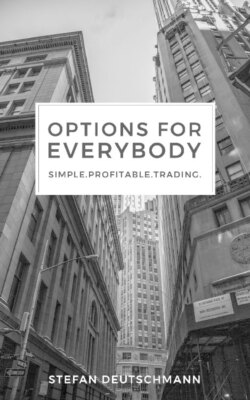Читать книгу Options for everybody - Stefan Deutschmann - Страница 10
На сайте Литреса книга снята с продажи.
2. Basics 2.1 Main Features of Options Contracts
ОглавлениеI think it's really important to understand the basics of something before you go into depth. No one is helped to build a house on a shaky foundation. That is why I am going to go over the characteristics of option contracts here.
An option contract consists of several components. First, the actual share on which we want to write options. Since these are not always equities, but can also be futures, we will use term underlyings. This could be an ETF ETN ETC / Futures or any other tradable product. So, first we choose the one we want to trade. All the following factors depend on this basic selection. The second part is the expiration date. As the name suggests, this is the day on which the option contract ends. Usually such an expiration date is always the third Friday in every month. Nevertheless, there are exceptions, for example, some underlyings have an expiration date every Friday, while the SPY (= ETF on the S&P 500), for example, has an additional two-day and quarterly expiration date. Futures are a bit different again, but they are not the subject of this book. For the sake of simplicity, however, we will be recording the third Friday of the month. So now we know which stock we want to trade in which cycle.
The third part of the contract is the strike price. This is the price at which you agree to either buy or sell the underlying shares in the future. Remember, this is not the price at which the stock is being traded. Let's say the underlying is trading at 50 USD. You are not forced to choose this price, but can say, for example, that you would only be willing to buy shares at 40 USD. The fourth part of the option contracts may seem a bit abstract at first, but you've already got to know it. This is the choice of "type". This simply depends on whether you want to trade call or put options. Basically there are only these two types - calls or puts. The big difference lies in how, in what way and in what relation to each other you use them so that they can unfold their full effect.
The last and fifth part of an option contract is the premium paid or received by the contracting parties. Remember, if you are an option buyer, you would pay a premium for this option contract in this case. If you are an option seller, you would receive the corresponding premium. That much has already been said at this point. You usually want to be on the option seller's side, collect premium and not spend them.
Premiums and options contracts usually have a 100-point multiplier (except for futures, for example). For example, if you see a premium of 1 USD, the actual value of the contract is 1 USD per share * 100 shares, or 100 USD. The displayed price refers to the premium for one share. An option contract always consists of 100 shares, therefore the multiplier comes in play.
In the course of time, we will get to know each of these components in greater detail, so that at some point an understanding of the big picture will emerge. Otherwise you will also have the opportunity to go back a few pages at any time and read them again.
Option-Chain
The above-mentioned information must now be presented in a clear manner so that every reader can understand and comprehend it. Also, I've already told you that it's possible to trade options without ever having to see a chart. To do just that, there is the so-called option chain.
An option chain is a matrix list for a single underlying that displays all puts, calls, strike prices and price information for a specific expiration period. The majority of online brokers and stock trading platforms display option prices in the form of an option chain with real-time or delayed data. The chain display enables fast scanning of activities, open interest rates and price changes. Traders can find out about the specific options required to fulfill a particular option strategy.
You can quickly find the trading activity of an asset including trading volume, premiums by strike price and expiration months. The data can be sorted by expiration date, most likely to the farthest away, and then further refined by exercise price - basically, in most applications, you are free to design your "chain" as you wish.
The terms in an option matrix are relatively self-explanatory. An experienced user can quickly decipher the market about price fluctuations and high and low liquidity. This is important information for efficient trading and profitability, and you'll find that this interpretation will become flesh and blood over time.
As a rule, you have four columns that you can determine, or you can decide which information is important for you. There is no general solution here, as every trader values different information and uses it for his interpretation. Each line and its meaning will be explained to you in detail throughout this book, so that you will be able to make your own informed decision. In order not to put you under any further torture, here is a screenshot of what such a option chain might look like in reality.
Figure 2 : Option chain of the SPY
Source: Screenshot, Brokersoftware Tastyworks
Remember:
An option consists of five main components:
Underlying Expiration date Strike / Type and premium.
A standard option has a multiplier of 100.
An option chain provides you with all relevant basic information at a glance and according to your preferences.
This allows you to trade options without having to see a single chart of the respective stock. This removes (in principle) all emotions from your own trading.
